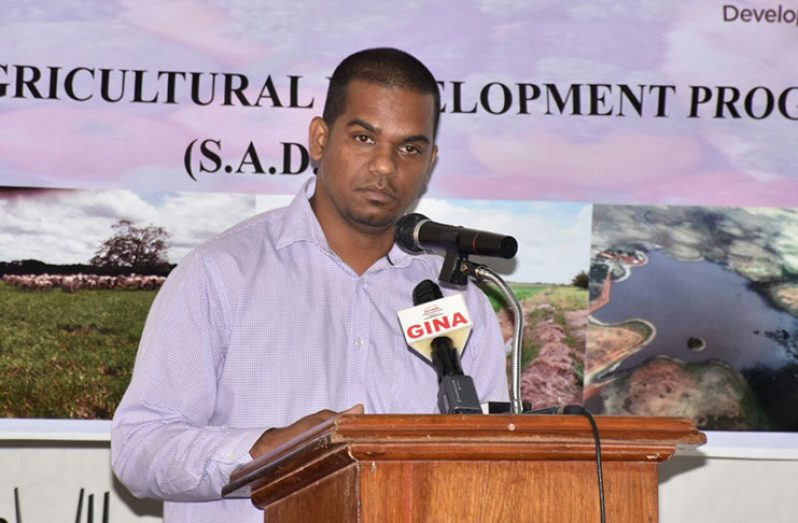THE Ministry of Agriculture on Wednesday launched a US$15 Million Sustainable Agricultural Development Programme (SADP), geared at increasing the productivity of the agricultural sector and maintaining sustainable climate-resilient use of natural resources in Guyana.
SADP, which has been on the ministry’s agenda for quite some time was awaiting the Inter-American Development Bank (IDB)’s approval of the funding. And on February 20, 2017, the government and the IDB entered into an agreement for the loan which will be used to boost the sector.
Speaking at the launch of SADP, Project Coordinator of the Agriculture Sector Development Unit (ASDU), Khemlall Alvin said that the implementation of the project will be done over a six-year period. During the life of the programme, the Ministry is anticipating that there will be higher private sector investments in the agricultural sector; an agricultural census implemented; higher productivity at the farm level; higher value of products processed by pilot facilities and increase in the use of practices that reduce pressure on ecosystems.
But, looking away from the macro benefits, Alvin said that the main beneficiaries of the programme will be farmers of Regions Five (Mahaica-Berbice), Nine (Upper Takutu-Upper Essequibo) and Ten (Upper Demerara-Berbice). “29,000 households from those three regions will benefit extensively from the programme…There will be finance incentives aimed at facilitating technology adoption and enhancing the profitability of selected farmers. Each farmer will receive up to US$500- a one-time incentive that will cover up 70 percent of the cost of the technology package financed by the programme,” said the project coordinator.
This, however, is only a fraction of what the programme has in store for the beneficiaries. The programme is divided into three components.
Alvin explained that Component One of the project will be based on generating information for evidence-based policy making and natural resource management. Through this component the ASDU and other stakeholders will review and design an Appropriate Agricultural Information System (AIS); train Ministry and Bureau of Statistics (BoS) staff members; and prepare and implement an agricultural census. With the gathering of information boosted, Component Two will see to the strengthening of the agricultural, innovation and extension system.
AGRICULTURAL CENTRES
“In Component two there will be the construction and rehabilitation of agricultural centres in Regions Nine and 10…The centres will house research programmes to be implemented by NAREI, GLDA and the Hydro Meteorological Service. The agriculture centres will also have facilities for the Guyana School of Agriculture (GSA) and the National Drainage and Irrigation Authority (NDIA),” said Alvin.
It was further outlined that ASDU will also design and construct a water reservoir to harvest rainfall that will facilitate irrigation and livestock research in the agriculture centres. Five research programmes will be implemented at each agricultural centre.
The final component (Component three) will be used to calibrate the sector. It will deal with the support for compliance with sanitary and phytosanitary standards. ASDU Project Coordinator said, “We will review and update the standards and codes related to products destined for export markets as well as local markets both current and potential.”
With these on stream, the Minister of Agriculture, Noel Holder, highlighted that the agricultural sector is expected to make a major contribution to our development of a green state by contributing to food and nutrition security, poverty eradication, adaptation to climate change, building resilience in the sector and increase in employment.
Holder stressed that they are expected to contribute to the Sustainable Development Goals 2030 agenda, through inputs in the areas of livestock, fisheries, crops, irrigation and drainage, pesticide management and control and marketing. “The vision of the government for the agricultural sector is the provision of technical support for a robust, evidence-based and effective planning platform that will facilitate the development of a modernized, productive, efficient and competitive agriculture sector that contributes to sustainable economic growth,” said the Minister.
FIRST CENSUS IN 65 YEARS
It starts with the ability to produce “high-quality” data for the agricultural sector. Holder pointed out that through Component One of SADP the sector will see the first agricultural census in 65 years, “an event which is supposed to happen every 10 years.”
The census will give planners and policymakers an understanding of the progress and future prospects of all agricultural industries and their products and of our farm practices. It will also help farmer, policymakers and others involved in the industry to determine strategies to ensure sustainable farming. Guyana’s agriculture sector must become “smarter, leaner and cleaner,” said Holder while noting that the country has fallen behind in its targets, and they (the ministry) have allowed agricultural research to have a lower priority.
IDB Country Representative, Sophie Makonnen alluded to the same point as the Minister. She said that Guyana has the potential to begin the diversification of its economy. However, diversification has already begun. NAREI’s Chief Executive Officer (CEO), Oudho Homenauth, in a report last year stated that with the hinterland agriculture diversification programme, growth in the new and other crops sub sector is projected at 2.5 percent in 2017. In 2016, farms were established at Hosororo, Ebini and Cato to facilitate trials of new crops. The soil types in these areas have been identified as an excellent source of required nutrients for planting such crops as Soursop.
With these facilities in place, major agricultural works will continue in 2017 at these hinterland stations where Watermelon, corn, tomato, turmeric, ginger and a number of other crops will be cultivated. Additional crops are also being explored to push the diversification process.




.png)









